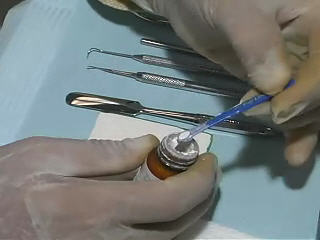
Back to Cements | Back to Operative Videos
Glass ionomer cements are high strength bases used primarily for permanent cement, as a base, and as a Class V filling material. They are supplied as a powder and a liquid, or as a powder that is mixed with water. The liquid is typically polyacrylic acid. The powder is an aluminosilicate glass; in some products, the polyacrylic acid is coated on the powder, in which case the liquid used is water or a dilute solution of tartaric acid in water.
Right-click here to download this video.
( Choose the "Save As ..." option from the menu.)
Moisten the prepared cavity.
Prior to mixing the cement, moisten the area to which the cement will be applied,
using a damp cotton pellet.
Mix the cement.
Shake the powder carefully and slowly to make sure that the contents are evenly
distributed in the bottle, without introducing too much air into the mixture.
Use the accompanying measuring spoon to measure exactly one level scoop of powder
and place it on the mixing pad.
Carefully shake the liquid and dispense one drop.
Mix the two by gently folding the powder into the liquid; mixing should take up to 15 seconds.
Apply the cement.
Using a calcium hydroxide applicator, pick up the cement and carefully place
it into the prepared cavity, allowing it to flow over the surface. Apply enough
cement to achieve a 0.5 mm thickness.
Cure the cement.
Cure for 20 seconds. Check the surface to ensure that setting is complete; there
should be no indentations. If necessary cure again.
The total thickness of the cement should be about 0.5 mm; if greater thickness is required, additional cement can be applied and cured in 0.5 mm increments.
The mixed glass ionomer cement can be applied as long as the surface of the mixed cement is shiny; if the surface becomes dull, it should discarded and new cement should be mixed.
Back to Cements | Back to Operative Videos